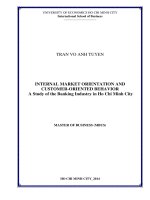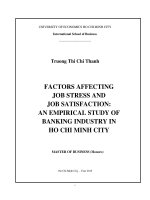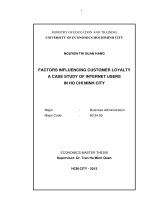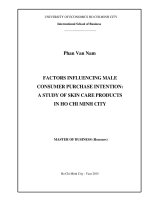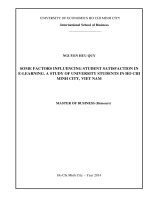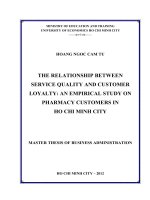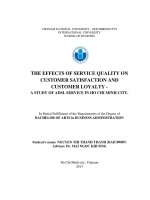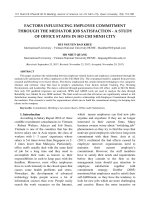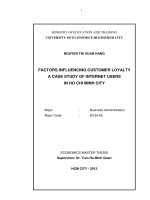Factors influencing customer loyalty a case study of internet users in ho chi minh city
Bạn đang xem bản rút gọn của tài liệu. Xem và tải ngay bản đầy đủ của tài liệu tại đây (611.65 KB, 86 trang )
i
MINISTRY OF EDUCATION AND TRAINING
UNIVERSITY OF ECONOMICS HOCHIMINH CITY
NGUYEN THI XUAN HANG
FACTORS INFLUENCING CUSTOMER LOYALTY
A CASE STUDY OF INTERNET USERS
IN HO CHI MINH CITY
Major
:
Business Administration
Major Code
:
60.34.05
ECONOMICS MASTER THESIS
Supervisor: Dr. Tran Ha Minh Quan
HCM CITY - 2012
ii
ACKNOWLEDGEMENTS
During working on this thesis, I have learned a lot and tried my best. I would
like to sincerely thank all the people who helped me to complete this thesis.
I would like to express my gratitude towards my supervisor Dr. Tran Ha
Minh Quan for his patience, helpful guidance, support and contribution. And
there is a special thank to my husband who always supports me in every
situation.
We also appreciate all the respondents who participated in my survey,
without your kind responses to the questionnaire I definitely could not
complete this study.
Thank all of you for your kind assistances and your valuable time.
iii
ABSTRACT
The purpose of this study to examine whether customer satisfaction,
switching cost, price perception, and corporate image are antecedents of
customer loyalty in the context of the internet service market in Ho Chi
Minh city. We explore the key antecedent of customer loyalty, and the
difference in Customer Loyalty among the three career groups.
The findings show that all of those 4 factors positively influence customer
loyalty. In addition, Customer satisfaction is a key antecedent of Customer
Loyalty. Furthermore, there is the different level of Customer Loyalty
among different three career groups. The studying people group has less
loyalty level than the working /working and studying people group. Besides,
the implication based on the result of the study as well as further research of
the study were also represented in this paper.
Keywords: Customer Loyalty; Customer Satisfaction; Switching cost;
Corporate Image; Price Perception; ISP (Internet Service Provider)
iv
CONTENTS
CHAPTER 1: INTRODUCTION
1.1 Research background ................................................................................ 1
1.2 Problem statement ..................................................................................... 2
1.3 Research questions and objectives ............................................................ 3
1.4 Research limitation .................................................................................... 4
1.5 Thesis structure ......................................................................................... 4
CHAPTER 2: LITERATURE REVIEW
2.1 Customer loyalty ....................................................................................... 6
2.1.1 Customer and loyalty customer ......................................................... 6
2.1.2 Definition of customer loyalty .......................................................... 7
2.1.3 Customer loyalty phases .................................................................... 8
2.1.4 Classifications of customer loyalty ................................................... 8
2.1.5 Importance of customer loyalty......................................................... 9
2.1.6 Loyalty programs and its benefits ................................................... 10
2.2 Antecedents of customer loyalty ............................................................. 14
2.2.1 Customer satisfaction ...................................................................... 14
2.2.2 Switching cost ................................................................................. 16
2.2.3 Corporate image .............................................................................. 17
2.2.4 Price perception ............................................................................... 18
2.3 Research model ........................................................................................ 20
CHAPTER 3: RESEARCH METHODOLOGY
3.1 Research design ...................................................................................... 22
3.1.1 Research method.................................................................................. 22
v
3.1.2 Exploratory study .............................................................................. 23
3.1.3 Main survey ....................................................................................... 24
3.1.3.1 Sample size .................................................................................. 24
3.1.3.2 Data collection procedure ............................................................ 24
3.1.3.3. Research process......................................................................... 25
3.2 Measurement .......................................................................................... 26
3.2.1 Measure of Customer satisfaction ..................................................... 26
3.2.2 Measure of Switching Cost ............................................................... 27
3.2.3 Measure of Corporate Image ............................................................. 28
3.2.4 Measure of Price Perception .............................................................. 28
3.2.5 Measure of Customer Loyalty ........................................................... 29
3.3 Data analysis method .............................................................................. 30
3.4 Summary ................................................................................................. 30
CHAPTER 4: DATA ANALYSIS AND RESULTS
4.1 Descriptive data analysis ........................................................................ 31
4.2 Testing factors of research model ........................................................... 33
4.2.1 EFA results of independent variables ................................................ 33
4.2.2 Exploring Factor Analysis (EFA)...................................................... 35
4.2.2.1 EFA results of independent variables. ......................................... 35
4.2.2.2 EFA results of dependent variable............................................... 37
4.3 Hypotheses testing ................................................................................. 37
4.3.1 Testing Assumptions of Multiple Regression ................................. 37
4.3.2 Testing hypotheses between Independent Variables and Customer
Loyalty............................................................................................. 38
4.4 Testing the relationship among qualitative factors and quantitative
variables ................................................................................................... 41
vi
4.4.1 Testing the relationship between gender and Customer Loyalty .... 41
4.4.2 Testing the different influence levels of career on Customer
Loyalty............................................................................................. 43
4.5 Customer’s evaluation on Customer Loyalty following using ISP ....... 45
4.6 Summary ................................................................................................. 46
CHAPTER 5: CONCLUSIONS
5.1 Conclusion .............................................................................................. 47
5.2 Managerial Implication........................................................................... 47
5.3 Implication for theory and future research ............................................. 49
References ........................................................................................................ 51
Appendices ...................................................................................................... 59
Appendix 1: Questionnaire in Vietnamese ................................................. 59
Appendix 1: Questionnaire in English ........................................................ 62
Appendix 2: Reliability results of measurement scales – Pilot test ........... 66
Appendix 3: EFA results of independent variables – Main survey............ 69
Appendix 4: EFA results of dependent variable – Main survey ................. 71
Appendix 5: Testing assumptions of multiple regression ........................... 72
Appendix 6: Histogram, Normal P – P plot and Scatter plot ...................... 73
Appendix 7: Multiple Regression Line results ........................................... 76
vii
LIST OF FIGURES
Figure 3.1 Fundamental differences between quantitative and qualitative research
strategies ..................................................................................................................... 22
Figure 3.2 Research process ............................................................................ 26
Figure 4.5 Mean of each used ISP name on Customer Loyalty ....................... 46
Figure 4.4 Histogram, Normal P – P plot and Scatter plot of Dependent
Variable – CL ................................................................................................... 73
viii
LIST OF TABLES
Table 3.1Scale of Customer Satisfaction ......................................................... 27
Table 3.2: Scale of Switching Cost .................................................................. 27
Table 3.3: Scale of Corporate Image ............................................................... 28
Table 3.4: Scale of Price Perception ................................................................ 29
Table 3.5: Scale of Customer Loyalty ............................................................. 29
Table 4.1 – Sample characteristics................................................................... 31
Table 4.2 Cronbach Alpha of observed variables ............................................ 33
Table 4.3: EFA for independent variables ....................................................... 36
Table 4.4: Multiple regression between independent variables and dependent
variable ............................................................................................................. 39
Table 4.5: Anova between independent variables and dependent variable ..... 39
Table 4.6: Coefficients between independent variables and dependent
variable ............................................................................................................. 40
Table 4.7 - Independent samples t-test results of gender factor and CL ......... 42
Table 4.8 The analysis results of the different influence levels of career
factor on Customer Loyalty ............................................................................. 43
Table 4.9 - Mean of each using ISP on Customer Loyalty .............................. 45
ix
ABBREVIATIONS
ISP: Internet Service Provider
EFA: Exploring Factor Analysis
MRL: Multiple Regression Model
1
Chapter 1: Introduction
The introduction chapter identifies the research background, present the
problem statement, the research questions, and introduce the research
methodology, the objectives as well as limitation of the study. In addition, the
significance of the research problem and the organization of the thesis are also
outlined.
1.1 Research background
The internet service market is growing very fast in many countries over the
world. And Vietnam is not an exception case. Up to July 2011, Vietnam has
29.5 million of people using Internet, equal to 33.99% of population, and
forecast increasing to 40% in 2012 (Ha Nam Khanh Giao & Tran Huu Ai,
2011) . Internet is one of the most common means of communication
nowadays. In Vietnam, internet contributes 42% of daily communication
means ( Internet service
market is growing very fast in over the world. Asia region has biggest internet
user number. Vietnam is one of the countries which has highest increasing
percentage of internet users in Asia region. There are many service providers in
Vietnam such as VNPT, FPT, Viettel, SPT, SCTV… Therefore, studying about
this service has inspired many researchers to devote more of their research
attention to this area
It has been figured out by previous researchers that as markets become
more competitive, firms are more likely to try maintaining their market share
by focusing on retaining current customers. It’s also obvious that when
competition and the costs of acquiring new customers increase, companies will
be more concentrated their strategic efforts on customer retention, therefore to
maintain customer long-term relationships becomes as a critical mission for
business. The significance of customer loyalty cannot be overemphasized
2
because it relates closely to the continued survival, as well as the future growth,
of companies. For a company to maintain a stable profit level when the market
reaches the saturation point, a defensive strategy aiming at retaining existing
customers is more important than an offensive one, which targets at expanding
the size of the overall market by inducing potential customers to subscribe to
its services (Ahmad & Buttle, 2002; Fornell, 1992).
As a result, many studies were conducted in this critical issue. They
developed an estimated different dynamic models to exam the relationships and
impact of the different antecedents on customer loyalty.
1.2 Problem statement
Nowadays the internet industry, like many of other ones, faces very stress
competition so a large scale of internet service provider’s resources must be
definitely devoted to the present customers to make them more satisfied in
order to retain them.
One important point of customer retention is its close relationship to the
company’s continued survival, and to strong and stable future growth.
Therefore, for a company to maintain a stable profit level and the subscription
level has reached the saturation point, a defensive strategy which strives to
retain existing customers is more important than an aggressive one, which
expands the size of the overall market by inducing potential customers.
In internet service, many studies prove that customer satisfaction and
quality service are the drivers of customer loyalty while customer perceived
value, trust, corporate image, price perception quality, and customer switching
costs have significant effects on customer loyalty (Lee, 2010; Cheng et al.,
2008; Yang & Peterson, 2004; Lam et al., 2004; Aydin & Ozer, 2005; Kim et
al., 2004; Julander & Soderlund, 2003; Nguyen & Leblanc, 2001; Jones et al.,
2000; Zeithaml et al., 1996).
3
Only customer satisfaction is not enough to explain customer loyalty in all
circumstances since customer still has a chance to freely choose suppliers
because of many reasons such as switching cost, corporate image, price
perception…
This study empirically analyzes whether customer satisfaction, switching
cost, price perception, and corporate image are antecedents of customer loyalty
in the context of the internet service market in Ho Chi Minh city. We examine
the key antecedents of customer loyalty.
1.3 Research questions and objectives
The research questions that are discussed in this study are as follows:
Question 1: What are the key determinants affect on customer loyalty in
internet market in Hoc Chi Minh city in Vietnam? By evaluating the influence
level of the factors on customer loyalty, the importance of increasing loyal
customer shall be highlighted to eventually help the managers identify the right
direction of their investment and keep their customers under a tough
competitive environment.
Question 2: Is there a significant difference in customer loyalty among
studying and working people, working people, and studying people? This is a
minor research question.
Based on the above research question, the objectives of this study are
outlined to examine key antecedents of customer loyalty and impact career on
customer loyalty, it explores:
1.
The impact of Customer Satisfaction, Switching Cost, Price
Perception, and Corporate Image on Customer Loyalty in internet
service in Ho Chi Minh city.
4
2.
The difference in Customer Loyalty among the three career groups –
This is a minor research objective.
1.4 Research limitation
This thesis would be an opening base to further researches in related area in
other service sectors, but in other hand it may have some limitations. There are
other factors that can influence Customer Loyalty, apart from factors suggested
in this thesis such as: service quality, demographic characteristics of customer,
customer’s usage pattern of internet service, etc are not studied in this research.
1.5 Thesis structure
This research is organized in five chapters.
Chapter 1: the introduction chapter. It includes a brief overview of the
research background, problems and objectives. The limitations and research
methodology, the implications of research, and structure are also presented.
Chapter 2: the literature review and conceptual model. This chapter
provides a deeply review of previous research on antecedents of customer
loyalty. Based on that, a conceptual model is proposed.
Chapter 3: the research methodology. An attention is concentrated on the
research design, then interprets and illustrates the way that primary and
secondary data is collected. The measurement scales apply for the research
factors will be determined clearly and suitably.
Chapter 4: Data analysis and results. It analyzes the collected data and
presents the findings from the survey in terms of the effective levels of these
factors (customer satisfaction, switching cost, corporate image and price
perception) on customer loyalty.
groups is discussed as well.
Besides, comparison among the survey
5
Chapter 5: Conclusion and implication. The chapter is final part of this
dissertation. The researcher will mention several recommendations for
managers of internet service provider in Ho Chi Minh City Market in terms of
the theoretical and managerial significance. In addition, this chapter also made
a brief summary about the main content of the dissertation and further research.
6
Chapter 2: Literature review & theoretical model
In this chapter, we present a theory background about customer loyalty, the
antecedents of customer loyalty and the relationships between each of the
antecedents and customer loyalty. Then, the hypotheses and the conceptual
framework are proposed.
2.1 Customer loyalty
2.1.1 Customer and loyalty customer
The term “customer” is commonly used to refer to end-users of a product or
is a generic term referring to anyone who receives a service or product from
some other person or group of people. Customer can be defined in different
ways by some researchers as below:
A customer is the most important person ever in this office … in person or
by mail.
A customer is not dependent on us… we are depend on him.
A customer is not an interruption of our work … he is the purpose of it. We
are not doing a favor by serving him … he is doing us a favor by giving us the
opportunity to do so.
A customer is not someone to argue or match wits with. Nobody ever won
an argument with a customer.
Loyal customer is one who (1) frequently uses a service provider, (2) really
likes the provider and appreciate it, and (3) does not want to looking for using
another service provider for this service. On contrast, an extremely “non-loyal”
person is one who (1) will never use the provider again, (2) has negative
feelings/thought about the provider, and (3) welcomes suggestions about other
providers and is willing to try any other provider. This three-dimensional
7
definition is consistent with Zeithaml et al., (1996) operationalization of the
“loyalty to company” factor in their behavioral-intentions battery. The five
items they use to measure loyalty include (1) saying positive things about the
company,(2) recommending the company to someone who seeks advice, (3)
encouraging friends and relatives to do business with the company, (4)
considering the company the first choice to buy services, and (5) doing more
business with the company in the next few years.
2.1.2 Definition of customer loyalty
We have many definitions supposed of customer loyalty by the scholars.
According to Griffin, (1996), customer loyalty is a purchase behavior, which,
unlike customer satisfaction, is an attitude. Customer loyalty is related to the
likelihood of a customer returning, making business referrals, providing strong
word of mouth, as well as offering references and publicity (Bowen &
Shoemaker, 1998). Customer loyalty is a key component for a brand’s longterm viability (Krishnamurthi and Raj, 1991). Oliver (1999) defines it as “a
deeply held commitment to re-buy or re-patronize a preferred product/service
consistently in the future, thereby causing repetitive same-brand or same brandset purchasing, despite situational influences and marketing efforts having the
potential to cause switching behavior”. Customer loyalty manifests itself in a
variety of behaviors, the more common ones being recommending a service
provider to other customers and repeatedly patronizing the provider (Dwyer,
Schurr, and Oh 1987; Fornell 1992; cited in Lam et al., 2004)
In generally, customer loyalty can be defined as occurring when customers
regularly purchase goods or services, have word of mouth, and make advices to
other customers.
8
2.1.3 Customer loyalty phases
Oliver (1999) proposes that customer loyalty has four phases.
The first phase is cognitive loyalty. Customers become loyal to a brand
based on what they know about that brand. For example, they are loyal with
that product brand/service because they get information of that product/service
quality is good and meets with their expectations.
The second phase is affective loyalty. It refers to customer liking or positive
attitudes toward a brand.
The third stage is conative loyalty that consumers have a behavioral
intention – committed deeply to buy. The intention leads to the fourth stage of
action.
The fourth phase is action loyalty. At this last stage customers turn
intentions into actions. Customers have the desire to overcome barriers which
might prevent the act to achieve the actual purchase behavior.
2.1.4 Classifications of customer loyalty
There are three kinds of customer loyalty approached as these conceptual
perspectives: behavioral loyalty/perspective, attitudinal loyalty/perspective, and
composite loyalty/perspective (Bowen & Chen, 2001; Zins, 2001).
Behavioral loyalty means consumers’ repurchase behavioral or intension of
specific brand (Russell-Bennett et al. 2007). Attitudinal loyalty means
consumers’ sense of specific products or service (Kumar and Reinartz, 2006).
Behavioral loyalty makes customer loyalty be converted into actual purchase
behaviors while attitudinal loyalty does not ensure that customers will purchase
merchandise themselves, but through word-of-mouth, they will help to create a
positive image of a business to others. This may not directly bring profit, but
indirectly
create
a
positive
result
to
company.
The
composite
9
loyalty/perspective combines attitudinal and behavioral perspective. It might be
considered as an alternative to affective loyalty since using both attitude and
behavior in a loyalty definition arguably increases the predictive power of
loyalty (Pritchard & Howard, 1997)
Jacoby and Kyner (1973) express customer loyalty by a set of six necessary
and collectively sufficient conditions by integrating both behavioral loyalty and
attitudinal loyalty: These conditions express that brand loyalty is (1) the biased
(i.e., random), (2) behavioral response (i.e., purchase), (3) expressed over time,
(4) by some decision-making unit, (5) with respect to one or more alternative
brands out of a set of such brands, and (6) is a function of psychological
(decision making, evaluative) process.
According to the study by Lam et al. (2004) loyalty is manifested in two
other ways: repeat patronage and recommendation. Zeithaml, Berry, and
Parasuraman (1996) propose a comprehensive multi-dimensional framework to
measure customer loyalty which includes both attitudinal loyalty and
behavioral loyalty.
In this research, customer loyalty includes both recommending and
patronizing actions. In the other words, it is composite loyalty.
2.1.5 Importance of customer loyalty
The more loyalists the organization has, the greater market share and higher
rates of return on investment they get. Asker (1991) discusses the role of
loyalty in the brand equity process and specially noted that brand loyalty leads
to certain advantages, such as reduced marketing costs, more new customers,
and greater trade leverage. In increasingly competitive markets, being able to
build consumer loyalty is seen as the key factor in winning market share and
developing a sustainable competitive advantage. Anderson et al. (2004) argued
a loyal and contented customer base helps to increase the organizations’
10
relative bargaining power regarding suppliers, partners and channels. That’s
why customer loyalty should affect shareholder value in a positive manner by
reducing instability and associated risk with expected future cash flows. Dick
and Basu (1994) propose that customer loyalty creates positive WOM
communication (word of mouth) and competitive strategies are resisted by
loyal customers. Based on many findings, strategists and marketers are
recommended to build and hold strong customer loyalty. Oliver (1999) agrees
with Dick and Basu that customer loyalty is engaged in affirmative word of
mouth communication. “Based on a 20-80 principle, the top 20% of the
customers may create 80% of profit for a company” (Kotler and Keller, 2005).
So, a favorable connection between a company and its customers is very
important for the business. Furthermore, in the financial services industry, the
study shows that increasing customer retention (or customer loyalty) by 5
percent could lead to 25-75 percent profit growth (Chan et al., 2001).
Therefore, customer loyalty becomes an ultimate target of most firms in the
highly competitive economy nowadays.
In conclusion, it is very necessary for a firm to focus on building loyal
customer as its long term strategy.
2.1.6 Loyalty programs and its benefits
Customer loyalty program have developed remarkably in the era of
customer retention in recent years. This is due to recent advances in
information technology. They have been considered by many organization and
many of them have adapted customer loyalty programs. According to Yi and
Jeon (2003) loyalty programs are introduced to build customer loyalty.
Customer loyalty programs have also been willingly embraced by customers;
this is due to he benefits associated with it (O’Malley, 1998). The importance
of benefits of enticing customer loyalty programs is to create a high level of
11
customer retention. Gilbert referred to O’Malley (1998) states that the basic
idea of a loyalty scheme is to reward customers’ repeat purchasing and
encourage loyalty by providing targets at which various benefits can be
achieved. The longer customer stays with an organization the more profit the
customer generates (Reichheld and Sasser, 1990). This is an outcome of a
number of factors relating to the time the customer spends with the
organization, and includes: the effects of the higher initial costs of introducing
at attracting a new customer; increase in the value of purchases; increase in the
number of purchases; the customer’s better understanding of the organization
and vice versa; and the last one positive word-of mouth. It was recognized by
Colgate et al. (1996) that reduction in defection can contribute to increases in
profits more than increasing the market share. The profits of organization can
increase by 100 percent through retaining 5 percents more of their customer
(Reichchel and Sasser, 1990,; O’Malley, 1998).
Moreover, from a customer perspective, loyalty scheme can be a way to
decrease price sensitivity, increase brand loyalty, reduce the willingness to
consider alternative brands, encourage word of mouth support and
endorsement, attract a larger group of customer and increase the amount
product bought (Uncle et at,., 2003).
Customer loyalty programs are assumed to create value for the customer
and it is due to this value that customer loyalty programs promote loyalty. On
the other hand, the degree to which customer loyalty programs offer value to
customers is uncertain, mostly because customers are not equal an dvalue will
represent different things to different people and will also be different in
different context (O’Malley, 1998). In order to make the value of customer
loyalty programs work properly and succeed, an organization needs to
understand the needs and desires of their customers. The value an organization
delivers to its customer needs to be competitive in five dimensions. Seen from
12
customer perspective, the dimensions are: cash value (as a percentage of the
proportion spends)., aspiration value (how much this reward motivates a
customer), relevance (the extent to which the rewards is achieved), and
convenience (ease of participation of the scheme), choice (the variety of
rewards offered) (O’Brien and Jones, 1995).
Even though a small number of schemes today offer all dimensions of
value, it is obvious that companies which want to play the rewards game should
be sure that their value measures up to customers’ alternatives (O’Brien and
Jones, 1995). This is most significant when customer loyalty programs are
mainly used as differentiation.
Due to the popularity and benefits derived from customer loyalty programs
many corporations have adapted these schemes. Customer loyalty programs
can and do build customer loyalty and corporation now realize how important
loyalty is for their profitability. One of the main reasons of creating loyalty
programs is to increase revenues, which can be done by either increasing
purchase and usage levels and also by increasing the range of products bought.
However, there are other reasons for increasing loyalty programs including: to
generate information, to reward loyal customers, to manipulate consumer
behavior and as defensive measure towards competitors (O’Malley, 1998).
Getting information about customers, who they are and their purchasing
behavior is a very important input for an organization. This information will
contribute to a better understand of the customer and corporation can use this
knowledge to improve targeting, creating offers and shift merchandise.
Furthermore, this knowledge can also be employed to reward customers to try
new products, manipulate consumer behavior.
A part from the benefits that longevity of customers brings, research
findings also suggest that the costs of customer retention activities are less than
13
the costs of acquiring new customer. Rust and Zahorik (1995) identify the
financial implications of customer retention, citing US office of consumer
Affairs research that estimates that attracting new customer maybe five times
as costly as keeping exiting customers.
Some of the most important benefits are as below:
Benefits for company:
•
Less costly to retain customers than to attract new customers
•
Generating profits
•
Decrease in marketing costs
•
Positive word of mouth, this is contribute to reputation of company
•
Benefits for customers:
•
Functional benefits:
o Time savings
o Convenience
o Economic benefits
o Risk reduction
•
Social benefits
o Relationships
Pleasant
Comfortable
o Trust
14
Now after reviewing the literature, the loyalty of the customer, its programs
and benefits, it is time to have a look at the different factors which affect this
concept.
2.2 Antecedents of customer loyalty
In internet service and mobile phone service, many studies prove that
customer satisfaction and quality service are the drivers of customer loyalty
while customer perceived value, trust, corporate image, price perception
quality, and customer switching costs have significant effects on customer
loyalty (Cheng et al., 2008; Yang and Peterson, 2004; Lam et al., 2004; Aydin
& Özer, 2005; Kim et al., 2004; Julander and Soderlund, 2003; Nguyen and
Leblanc, 2001; Jones et al., 2000; Zeithaml et al., 1996).
Even though we have many antecedent factors affecting customer loyalty,
but we cannot exam and find out the effects of all factors in the same study at
the same time. Therefore, in this research we use four antecedents such as
customer satisfaction, price perception, corporate image, and switching cost to
test their effects on customer loyalty of the internet service users in Ho Chi
Minh city in VietNam.
2.2.1 Customer satisfaction
Some of the definitions given by scholars for customer satisfaction (CS) are
as follows:
•
Anderson et al. (1994) suggest that overall customer satisfaction is
based primarily on the experience and satisfaction while purchasing
merchandise or services: it is both an emotional evaluation and a process of
comparison between a “pre-consumption expectation” and the “postconsumption perceived performance”
15
•
Tse and Wilton (1988) defines satisfaction as “the consumer’s
response to the evaluation of the perceived discrepancy between prior
expectations (or some other norm of performance) and the actual
performance of the product as perceived after its consumption”
•
Oliver (1997, 1999) proposes satisfaction as a fulfillment response or
judgment on a product or service, which is evaluated for one-time or
ongoing consumption.
•
Fornell (1992) suggests satisfaction as an overall evaluation based on
the total purchase and consumption experience of the target product, or
service performance compared with prepurchase expectations over time
•
“Satisfaction is a person’s feeling of pleasure or disappointment
resulting from comparing a product’s performance (outcome) in relation to
his or her expectation.‟ (Kotler & Keller, 2006).
In this study we use definition of customer satisfaction from Oliver (1997,
1999). There are many benefits for a company from a high customer
satisfaction level. Anderson et al. (1994) suggest that overall customer
satisfaction is based primarily on the experience and satisfaction while
purchasing merchandise or services: it is both an emotional evaluation and a
process of comparison between a “pre-consumption expectation” and the “postconsumption perceived performance”. Reichheld and Saser (1990) argue that
improved customer satisfaction will affect the likelihood of repeat purchases.
Taylor and Baker (1994) based their studies on four service industries in their
examination of the relationships between service quality, customer satisfaction,
and customer purchase intention. They determined that customer satisfaction is
positively correlated to purchase intention. Fornell et al. (1996) also maintain
that after a customer purchases a product or service, an attitude will be formed,
which is satisfaction. If satisfaction is high, the likelihood of repeat patronage
is great. This will create an attitudinal loyalty whereby the customer will
16
recommend the product or service through word of mouth. In internet services
industry, many recent studies prove that customer satisfaction positively
affected customer loyalty (Cheng et al., 2008; Yang & Peterson, 2004; Chiou,
2003). Thus, the first research hypothesis is:
H1: There is a positive relationship between customer satisfaction and
customer loyalty
2.2.2 Switching cost
Switching cost is defined as one-time costs incurred by the customer/buyer
for changing from an existing service/product to another (Porter, 1998). In
addition to objectively measurable monetary costs, switching costs may also
pertain to the time and psychological effort involved in facing the uncertainty
of dealing with a new service provider (Bloemer et al., 1998, Klemperer, 1987,
cited in Aydin & Özer, 2005). Switching cost is the sum of economic,
psychological and physical costs (Jackson, 1985). There are three types of
switching costs such as transaction costs, learning costs, and artificial switching
costs (Klemperer,1987). Dick and Basu (1994) defines switching cost includes
time, money and psychological cost.
In this study, we use definition of switching cost from is a sum of
economic, psychological cost and learning cost. It is in line with the definition
of switching cost defined by Jones et al., (2000) switching costs are consumer
perceptions of the time, money, and effort associated with changing service
providers.
The first one is the economic or financial switching cost is assumed as a
sunk cost which appears when the customer changes his/her brand. The second
is psychological cost is perceived as the cost stemming from social bonds (e.g.
staff-customer relations, etc.) that appear over the course of time and the
uncertainty/risk of the unused brand. The customer perceives high risk

